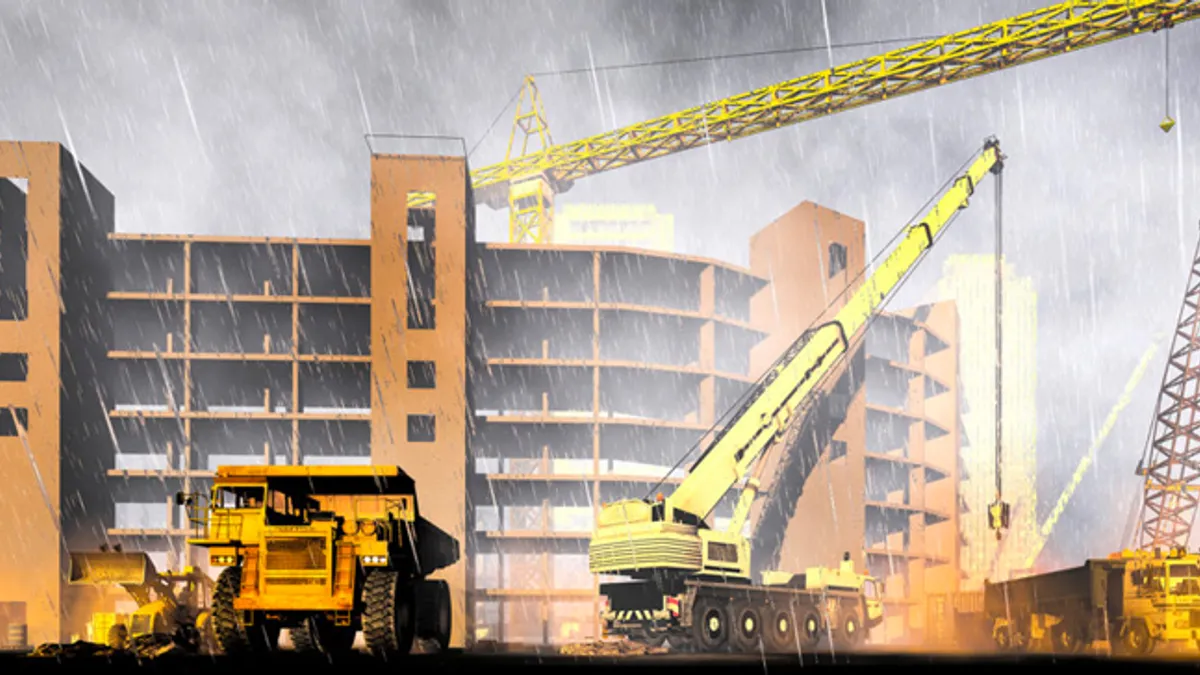Weather forecasters are warning that severe weather may throw another challenge to contractors' profitability this year. In May, the U.S. National Oceanic and Atmospheric Administration (NOAA) issued its forecast for the 2021 hurricane season (June 1 through November 30) and expects an above-normal season with as many as 20 named storms. About half of these storms will become hurricanes.
An increase in the number of predicted severe weather events will affect contractors everywhere. These storms and their remnants can travel hundreds of miles, impacting job sites with torrential rainfalls, tornados and flooding.
Fortunately, you can take steps to protect your job sites during a tumultuous hurricane season.
Know your insurance coverage
Double-check the list of perils included in your construction risk insurance policies. Often called "Builders Liability Insurance," these policies provide damage coverage at building sites from common exposures to fire, tornados, lightning and hail. Be aware that some policies do not cover earthquake, flood or hurricane damage. This is especially true when working in coastal regions identified as hurricane zones. If you are a subcontractor, check with your general contractors and project owners to confirm coverage. Be sure to identify any potential liabilities, such as damage to floors or slabs, which may not be covered under a basic builder's liability insurance policy.
Understand how your contract treats weather-related delays
When negotiating contracts, be aware of how they establish entitlement time extensions for weather delays. Protect yourself by setting guidelines should weather significantly delay the project or your access to the project. Contracts should specifically address how weather-related time extensions will be determined and administered.
Have a plan for when storm warnings are issued
Today's weather forecasting technology provides up-to-the minute status of severe weather events. It's important to establish simple procedures for your crews for when a storm warning is issued. Consider including the following steps in your plan.
-
Assign a "storm leader" to coordinate crew assignments.
-
After an initial warning, focus on work that, once completed, reduces a storm's impact, such as closing structural openings and minimizing rainfall or groundwater flow.
-
Protect materials or equipment that cannot be moved with netting, banding materials, self-tapping concrete anchoring screws or other materials.
-
Make a video/photographic record of the job site and surrounding properties to document the project condition and work status before the storm.
Establish proper safety procedures for a safe return
Review the Occupational Safety and Health Administration's (OSHA) Hurricane eMatrix, a comprehensive guide that covers post-storm activities. It provides detailed information and recommendations about how to protect workers when returning to a storm-ravaged area.
Pay particular attention to personal protective equipment, safe work practice, and precautions for recovery activities.
Get back to work safely
Even with the best planning, ramping up work on a storm-damaged construction site presents unique challenges. When returning to a job site, keep the following steps in mind to minimize hazards and get back to work safely.
-
Inspect the site and determine the extent of the damage.
-
Clearly communicate who is responsible for any repairs and clean-up, but notify the owner and their insurer before making repairs.
-
Make a second video/photographic record of the job site and surrounding properties to document the post-storm project condition before returning to work.
-
Assess the structural integrity of buildings, formwork and scaffolding. Reinforce and secure as needed.
-
Remove standing water.
-
Before re-powering the site, double-check all electrical connections, junction boxes and grounding. Pay close attention to the condition and placement of extension cords.
Account for all storm-related losses and disruptions
Construction disruptions are expensive, and it's important to account for all storm-related losses and disruptions. This should include the measurable costs of labor and materials involved in de-mobilization and re-mobilization due to storms and the additional repair costs resulting from the storm itself.
Subcontractors should document how storm-related delays impact their work, noting days when crews were sent home or were unable to work due to weather, field conditions and even delays caused by other crafts.
Another best practice is to compare the number of days that the actual precipitation from the storm exceeded the monthly average. This type of reporting is also useful when work is disrupted from either very cold or hot conditions that restrict safe work.
Being prepared can mitigate exposure
The Congressional Budget Office predicts that expected annual economic losses from most types of damage caused by hurricane winds and storm-related flooding total $54 billion, and $9 billion of this estimate will affect commercial businesses. But by taking time to plan now, you can mitigate exposure to this year's storm season, whatever it brings.










